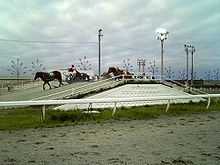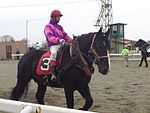Ban'ei
 Ban'ei horses in Obihiro Racecourse | |
| Country of origin | Japan |
|---|---|
| Horse (Equus ferus caballus) | |
Ban'ei (輓曳 or ばんえい) is a form of horse racing, unique to the Tokachi area of Hokkaido, Japan. Powerfully-built horses compete by pulling heavily-weighted sleds up sand ramps while being urged on by jockeys sitting on top of the sleds.
The horses used in the races are Percheron, Breton, and Belgian breeds.
Formerly held in a number of places, ban'ei races are now only held at the Obihiro Racecourse. The popularity of the races has waned in recent years and the Obihiro racecourse nearly closed before Softbank, a Japanese mobile phone company known for its tie-up with Apple and the iPhone, provided funds for the races to continue. Former racehorses are usually sold for meat rather than put out to pasture until old age.[1]
History
Ban’ei has its probable origin in agricultural work, when horses were used to cultivate crops and pull sleds of wood. Eventually, the horses were tested for speed in festivals of the late Meiji Era.
The popularity of ban’ei grew, and in 1953, Hokkaido’s four cities (Kitami, Asahikawa, Iwamizawa, and Obihiro) began to manage ban’ei. They ran the races until three of them closed operations in 2007 due to declining revenues. Obihiro racecourse is the only one currently active.
Course

The course consists of a flat dirt track, 200 meters long. Two cants are in the course; the second one is called the “Ban’ei Point”, and turns very sharply. Horses run the course in their own tracks, separated by lines. Horses haul their sledges, its weight including jockeys is more than 400kg, 1t in big race like the “Ban’ei Kinen” (domestic Ban’ei Grade 1 (BG1)). Thus the winning time of big race is often slower than lower class races.
Unique Points
There are some differences between a standard flat race and ban’ei. In ban’ei, a horse has not finished the race until the end of the sledge passes the finish line. Second, horses can stop after passing the first cant. Sometimes, jockeys make their horses stop to give them a rest before climbing the second cant. Third, jockeys do not ride the horse. They sit on the sledge. Fourth, jockeys do not have a riding crop or horsewhip. They use only the reins for control and to urge the horses.
Horses

Ban’ei horses are larger than other types of racehorses. They were bred by some heavy or robust breeds: Percheron, Breton, and Belgian and their weight can surpass 1 metric ton; twice that of a thoroughbred. Today, they are registered as Nihon Bankei Shu by Japan Equine Affairs Association.
Valuable horses
- Kintaro (1977 - 1992) won 32 races, winning 116,725,000 yen.
- Takara Fuji (1981 - ) won 27 races, winning 103,490,000 yen.
- Hikaru Tenryu (1983 - ) won 27 races, winning 104,611,000 yen.
- Asagiri (1985 - ) won 41 races, winning 102,512,000 yen.
- Maruzen Burgi (1986 - ) won 22 races, winning 107,517,000 yen.
- Fukuichi (1989 - ) won 30 races, winning 111,481,000 yen.
- Super Pegasus (1996 - 2007) won 42 races, winning 100,739,000 yen.
Famous jockey
Akihiko Kanayama is a former Ban'ei jockey. He won 3,299 races, and became known by the name of "Mr. Ban'ei". He is now a Ban'ei horse trainer.
Races (Ban'ei grade race)
All held in Obihiro, over 200 metres.
Two-year-olds
- BG1
- The Irene Kinen (イレネー記念)
- BG2
- The Kuroyuri Sho (黒ユリ賞)
- BG3
- The Nanakamado Sho (ナナカマド賞)
- The Young Championship (ヤングチャンピオンシップ)
Three-year-olds
- BG1
- The Ban'ei Derby (ばんえいダービー)
- The Ban'ei Oaks (ばんえいオークス)
- BG2
- The Ban'ei Kikka Sho (ばんえい菊花賞)
- BG3
- The Ban'ei Daishoten (ばんえい大賞典)
Four-year-olds
- BG1
- The Temma Sho (天馬賞)
- BG2
- The Ginga Sho (銀河賞)
- BG3
- The Hakurin Sho (柏林賞)
- The Queen Cup (クインカップ)
Three and Four-year-olds
- BG3
- The Hamanasu Sho (はまなす賞)
- The Poplar Sho (ポプラ賞)
Three-year-olds and up
- BG1
- The Ban'ei Grand Prix (ばんえいグランプリ)
- The Obihiro Kinen (帯広記念)
- The Ban'ei Kinen (ばんえい記念)
- BG2
- The Ban'ei Tokachi Oddspark Hai (ばんえい十勝オッズパーク杯)
- The Iwamizawa Kinen (岩見沢記念)
- The Kitami Kinen (北見記念)
- The Heroines Cup (ヒロインズカップ)
- The Champion Cup (チャンピオンカップ)
- BG3
- The Asahikawa Kinen (旭川記念)
- The Hokuto Sho (北斗賞)
- The Dream Age Cup (ドリームエイジカップ)
References
- Notes
External links
| Wikimedia Commons has media related to Ban'ei. |
| |||||||||||||||||||||||||||||||||||||||||
| ||||||||||||||||||||||||||||
.jpg)